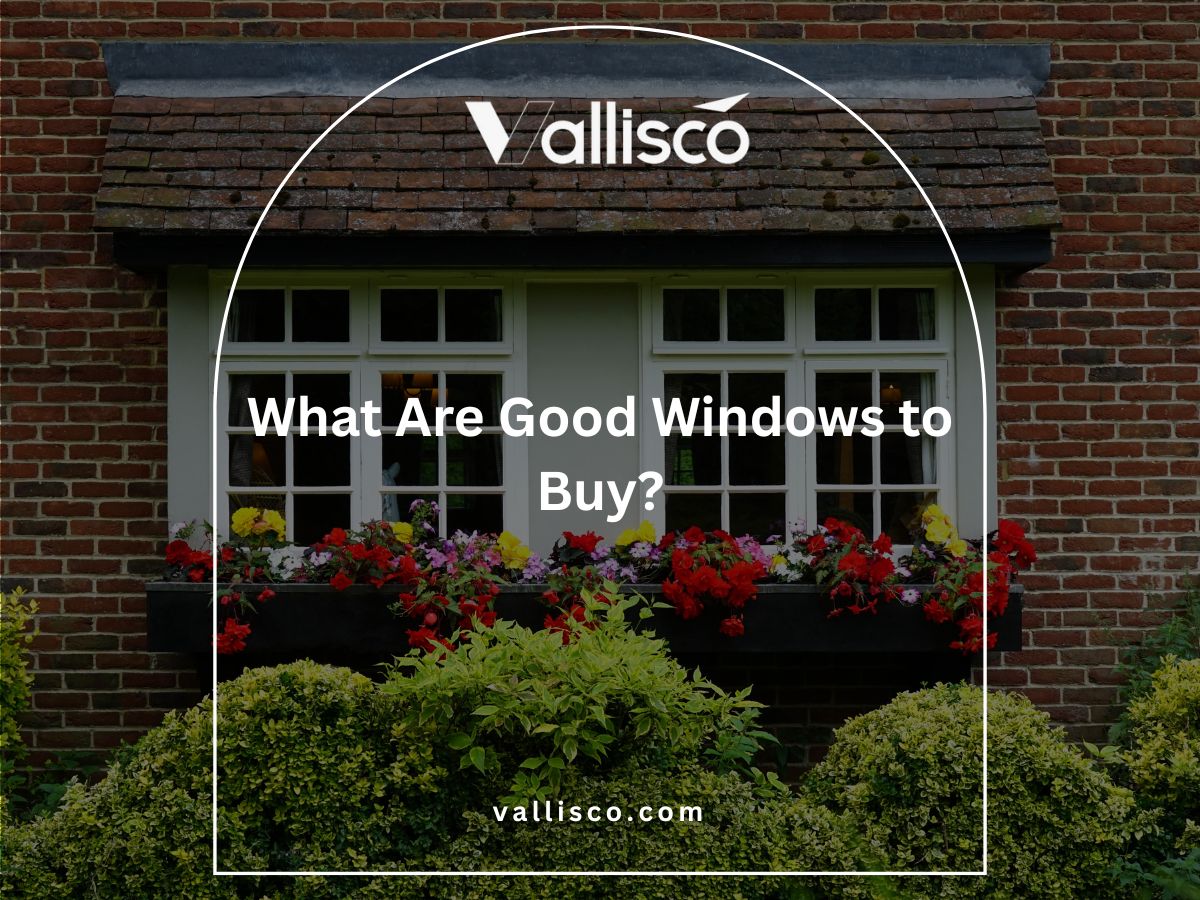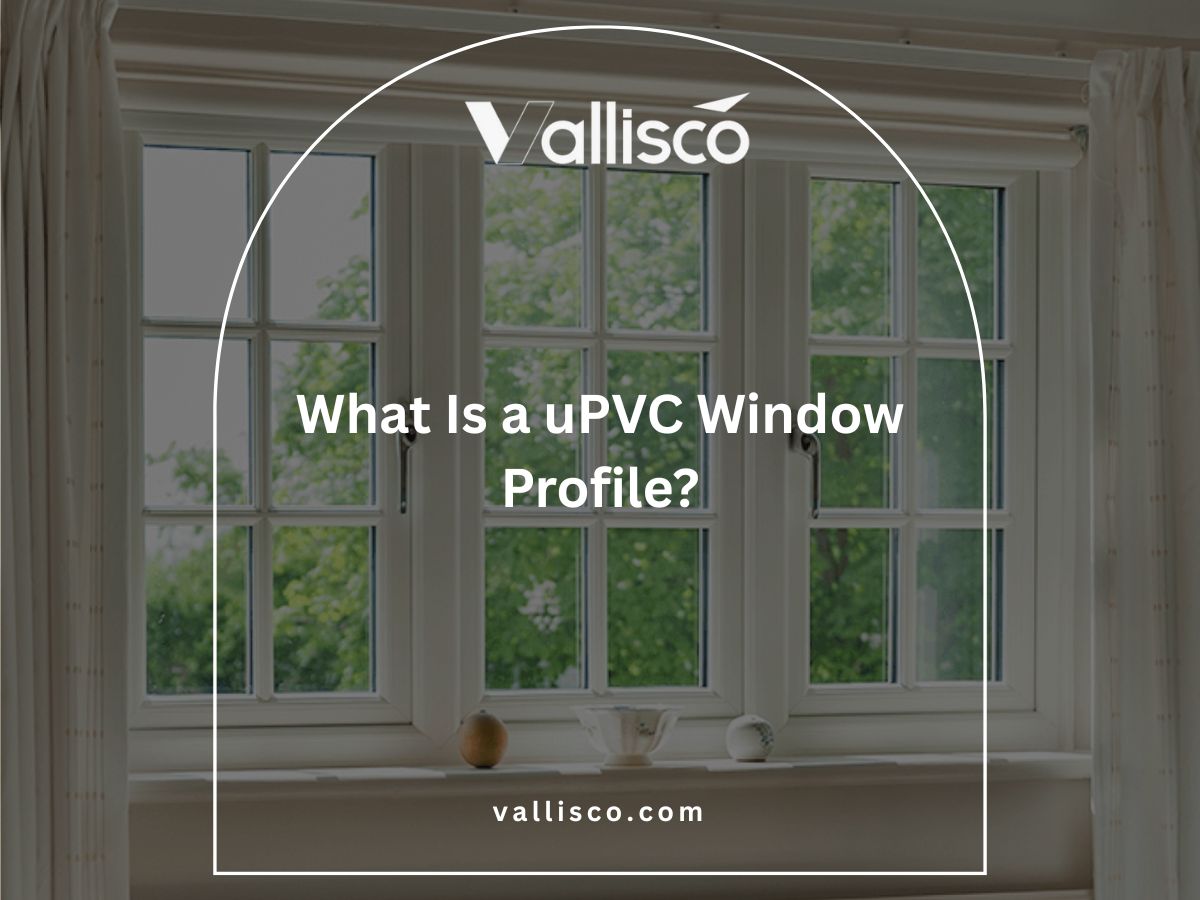I remember visiting a project site where a set of oversized glass doors had just been installed. The sunlight poured through without glare, and the frame lines were so slim they seemed to disappear.
It was the kind of finish you only get when every detail is planned with precision.
That moment reminded me how design choices in doors and windows influence more than appearance. They shape the experience of everyone who walks through them.
I’ve spent years working directly with the teams who build, install, and test these products. I’ve seen the impact of material upgrades, innovative hardware, and design features that deliver real benefits for properties of every size.
In this article, you’ll discover 10 trends in commercial door and window design that are changing how spaces look, feel, and function. You’ll get clear insight to help you choose styles, materials, and features that will work for your own projects.
So let’s begin!
Quick Comparison Chart
Before we get into the details, here’s a quick look at what each door and window design brings to the table. It’s a simple side-by-side comparison to help you spot what stands out and what fits your needs.
| Type | Key Benefit | Best Used For | A Note to Keep in Mind |
| Floor-to-Ceiling Glass Doors | Opens up space visually | Main entrances, indoor-outdoor flow | May need regular cleaning |
| Slim Profile Door Frames | Clean, modern look | Minimalist or modern interiors | Less structure, needs strong install |
| Smart Entry Door Systems | Keyless, remote control | Front entries or shared access | Needs power source or backup |
| Thermally Broken Door Frames | Energy savings, comfort | Hot/cold climates, exterior doors | Higher cost than basic metal |
| Multi-Panel Sliding/Folding Doors | Flexible wall openings | Lounges, patios, event spaces | Tracks need cleaning |
| Floor-to-Ceiling Glass Windows | Light and view | Scenic or smaller spaces | Glare or privacy may be a concern |
| Slim Profile Aluminum Windows | More glass, less bulk | Modern builds, natural light | Less insulation without upgrade |
| Smart Windows w/ Blinds + Sensors | Automated comfort | Offices, meeting rooms, high sun | Needs setup and power |
| Insulated Windows w/ Low-E Glazing | Heat control, energy savings | Direct sun or seasonal weather | Slightly reduces natural warmth |
| Integrated Ventilation Windows | Fresh air without opening | Bedrooms, hotel rooms, humid areas | Allows limited airflow |
Alright, ready to look closer? Let’s break each one down next.
1. Floor-to-Ceiling Glass Doors
I still remember walking into a newly opened hotel lobby and feeling the sunlight wrap around me the second I stepped inside. The glass doors stretched from the floor all the way up to the ceiling, letting in the kind of light that instantly changes space.
Guests paused before entering, almost as if they were taking in a view instead of just walking through. That moment reminded me how much an entry can influence first impressions.
Key Features and Materials
- Tempered Glass: Heat-treated for extra strength, making it less likely to break from impact. If it does break, it shatters into small, blunt pieces instead of sharp shards.
- Laminated Glass: Made with a plastic interlayer between two glass sheets, it holds together if broken. This also helps with noise reduction and added security.
- Frame Materials: Aluminum, steel, or composite frames give strength while supporting large panels. Finishes like powder coating can protect against corrosion and wear.
- Glare Control Coatings: Tinted or Low-E coated glass can help reduce heat and glare without blocking natural light. These coatings also protect interior furnishings from UV damage.
Best Applications
- Hotel Entrances: Create a grand, light-filled welcome that impresses guests the moment they arrive. Works well in both modern and classic designs.
- Villa Patios: Connect indoor living spaces directly to gardens or pools. Adds openness and blends the outdoor view with the interior design.
- Greenhouse Doorways: Allows maximum light entry for plant growth. Keeps the indoor climate stable while offering a clear view of the surroundings.
Performance and Maintenance
Good weather sealing helps reduce heat loss and keep interiors comfortable. Regular cleaning with the right tools keeps panels clear, even in high-traffic locations. Large glass surfaces benefit from extendable squeegees and mild cleaning solutions to avoid scratching.
Why Choose This Design
Floor-to-ceiling glass doors change how people experience a building. They open the space, frame views, and create a welcoming feel. Choosing this style builds more than an entrance: it shapes a lasting first impression. Vallisco offers glass door systems that bring in light, connect you to the outdoors, and add comfort at every step.

2. Slim Profile Door Frames
A few years ago, I walked into a villa project where the owners had replaced their old, bulky doors with new slim profile frames. The difference was immediate: the glass area seemed bigger, the view felt uninterrupted, and the entire room looked brighter. It reminded me that sometimes the frame you hardly notice is the one that changes everything.
Key Features and Materials
- Narrow Frame Design: Reduces the amount of visible frames, giving you more glass and better views. Creates a modern, streamlined appearance that works well in many settings.
- Durable Materials: Commonly made from aluminum or steel for strength without excess bulk. These materials also resist warping and can handle varying weather conditions.
- Finish Options: Powder-coated or anodized finishes protect the surface from corrosion. They also allow for different colors to match your property’s style.
- Thermal Break Integration: Adds an insulating layer between the inner and outer frame to reduce heat transfer. Helps maintain indoor comfort year-round.
Best Applications
- Modern Villas: Perfect for homeowners who want wide, open views without heavy framing. Brings a sleek, contemporary look to living spaces.
- Hotels and Resorts: Creates a more luxurious feel in guest areas and public spaces. Works well in both exterior and interior doorways.
- Commercial Storefronts: Attracts attention by showcasing interiors without visual obstruction. Enhances natural lighting inside space.
Performance and Maintenance
Slim profiles need regular cleaning to keep their edges looking sharp. In coastal or humid areas, selecting the right finish helps prevent corrosion. Occasional inspection of seals ensures the door maintains its insulation performance.
Why Choose This Design
Slim profile door frames bring in more light and create cleaner sightlines. They let the view be the focus while still offering the strength and durability your project needs. Choosing them means your doors work quietly in the background while transforming how space feels.
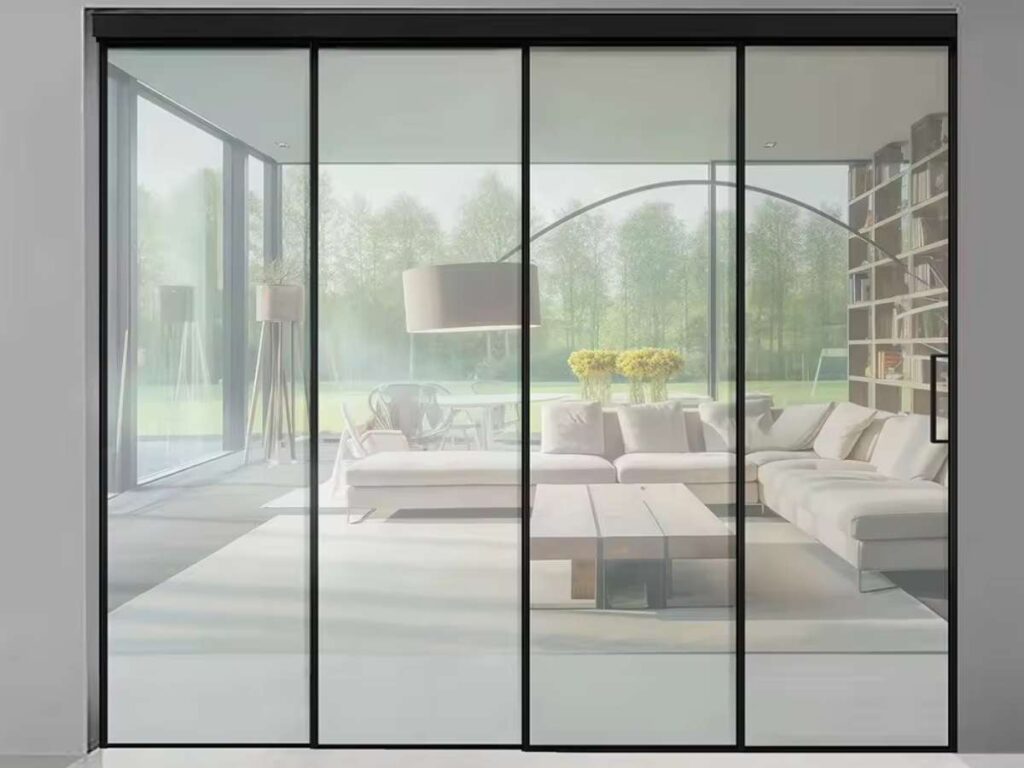
3. Smart Entry Door Systems
During a recent visit to a hotel, the main entrance doors opened automatically as soon as I approached, no touch required. A small sensor above the frame detected movement, and within seconds I was inside without breaking stride. The experience felt smooth and secure at the same time, and it was clear how much easier it made life for guests carrying luggage or arriving late at night.
Key Features and Materials
- Access Control Options: Can be set up with key cards, biometric scans, or smartphone apps. Offers flexible access for guests, staff, or delivery teams.
- Integration with Security Systems: Works alongside alarms, cameras, and building management tools. Provides centralized control from a single interface.
- Durable Frames and Hardware: Made from materials like aluminum or stainless steel for strength and weather resistance. Concealed wiring keeps the design clean.
- Backup Power Supply: Maintains function during power cuts. Prevents lockouts and keeps security active.
Best Applications
- Hotels and Inns: Offers convenient, hands-free access for guests arriving at all hours. Reduces wait times at the reception desk.
- Office Buildings: Controls who can enter restricted areas. Keeps records of entry times for security audits.
- Healthcare Facilities: Provides secure, easy access without touching handles. Helps maintain hygiene in sensitive environments.
Performance and Maintenance
These systems need occasional software updates to stay secure. Hardware should be inspected regularly to keep sensors, motors, and locks in good working order. Cleaning sensor areas helps maintain fast response times.
Why Choose This Design
Smart entry door systems offer both convenience and advanced security. However, they also improve the flow of movement, make access faster, and create a safer, more welcoming experience for everyone who enters. By adapting to the needs of modern commercial spaces, they bring a level of functionality that blends security with style, making daily operations smoother and more efficient.
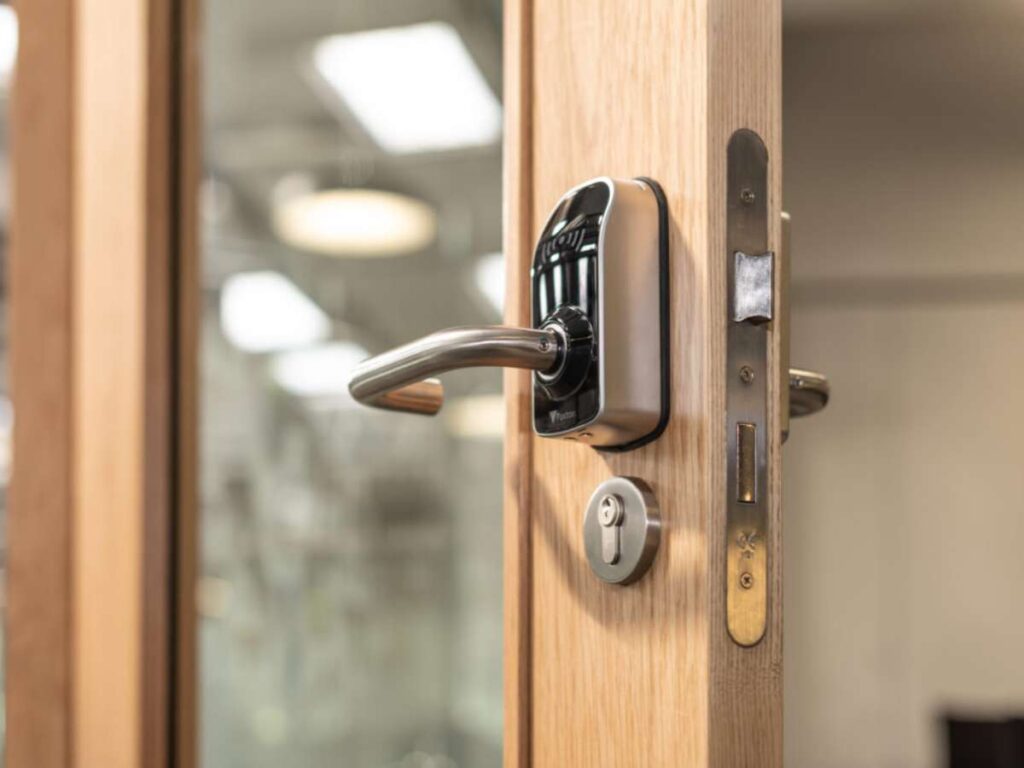
4. Thermally Broken Door Frames
On a recent resort project in a coastal area, I noticed how the entrance doors stayed cool to the touch even under strong sunlight. The secret was thermally broken door frames, which use an insulating barrier to slow heat or cold from passing through. This kept the lobby comfortable and reduced strain on the air conditioning. Here is an example of how the right frame choice can improve comfort and energy performance.
Key Features and Materials
- Thermal Break Construction: Separates the inner and outer metal parts with a non-metallic barrier. Reduces heat transfer and prevents condensation.
- Durable Frame Materials: Often made from aluminum or steel for strength and weather resistance. The thermal break material is usually polyamide or polyurethane.
- Compatibility with Glazing: Works well with double or triple-glazed panels. Improves overall energy savings and comfort.
- Finish Options: Powder coating or anodizing protects the frame and offers color choices to match the building’s style.
Best Applications
- Hotels in Hot or Cold Climates: Keeps interiors more comfortable without relying heavily on heating or cooling systems.
- Villas and High-End Homes: Balances performance with a refined appearance.
- Commercial Entrances: Maintains consistent indoor temperatures in busy public areas.
Performance and Maintenance
Thermally broken frames require little upkeep beyond regular cleaning. Checking the seals and gaskets helps maintain performance over time. These frames are built to last even in areas with harsh weather.
Why Choose This Design
Thermally broken door frames improve comfort and help control energy costs. However, they can have a higher initial cost compared to standard frames, which means you should weigh the long-term energy savings against the upfront investment.
5. Multi-Panel Sliding and Folding Doors
While visiting a restaurant renovation, I watched the crew open an entire wall of glass by sliding and folding the panels neatly to the side, turning the indoor dining area into part of the terrace. These doors are made of multiple connected panels that slide or fold along a track, creating wide, unobstructed openings, and this is a clear example of how they add flexibility and transform spaces in ways standard doors cannot match.
Key Features and Materials
- Panel Configurations: Available in bi-fold, accordion, or multi-slide setups. Let’s choose the best layout for your space and traffic flow.
- Frame Materials: Commonly made from aluminum or composite for strength with less weight. These materials resist warping and handle varying weather conditions well.
- Track and Hardware Quality: Smooth-gliding tracks and strong rollers make operation effortless. Seals and locks keep the opening weather-tight when closed.
- Glass Options: Can use clear, tinted, or insulated glass to control light, privacy, and energy performance.
Best Applications
- Restaurant Patios: Connects indoor and outdoor dining areas. Increases seating flexibility during peak hours.
- Villa Terraces: Opens living spaces directly to gardens or pools. Makes entertaining easier and more inviting.
- Event Spaces: Allows quick changes to room layouts. Useful for weddings, conferences, and exhibitions.
Performance and Maintenance
Regular cleaning of tracks prevents dirt buildup that can affect operation. Lubricating rollers helps maintain smooth movement. Checking seals ensures the door stays weather-resistant over time.
Why Choose This Design
Multi-panel sliding and folding doors offer unmatched flexibility and visual impact. However, they require more maintenance than standard doors to keep moving parts operating smoothly, so plan for regular care to protect your investment.

6. Floor-to-Ceiling Glass Windows
During a hotel renovation project, I stepped into a room where the entire wall was made of glass from the floor to the ceiling, and the view stretched for miles. The space felt open, bright, and connected to the outside in a way regular windows could never match. These are large glass installations that span the full height of a wall, and this is a striking example of how they can change the atmosphere of any commercial property.
Key Features and Materials
- Full-Height Glass Panels: Covers the entire height of the wall to maximize views and natural light. Creates a seamless indoor-outdoor connection.
- Glass Types: Options include clear, tinted, or Low-E coated glass. Each choice affects light levels, energy performance, and privacy.
- Structural Support: Requires strong frames or hidden reinforcements to handle wind loads. Ensures stability even in challenging weather conditions.
- Frame Materials: Aluminum and steel are common for strength and minimal visual obstruction. Finishes can match the building’s design style.
Best Applications
- Hotel Suites and Lobbies: Highlights scenic surroundings and adds a luxury feel. Works well in properties near mountains, oceans, or city skylines.
- Greenhouses: Provides maximum daylight for plant growth while keeping interior temperatures controlled.
- Commercial Offices: Creates an inspiring work environment with expansive outdoor views.
Performance and Maintenance
Proper sealing helps reduce drafts and condensation. Cleaning can be challenging for taller installations, so using extendable tools or professional services keeps them clear. Choosing glass with easy-clean coatings can reduce the frequency of maintenance.
Why Choose This Design
Floor-to-ceiling glass windows transform how people experience a space by filling it with light and views. However, they can increase heat gain in sunny climates, so additional shading or glazing solutions may be needed to maintain comfort indoors.
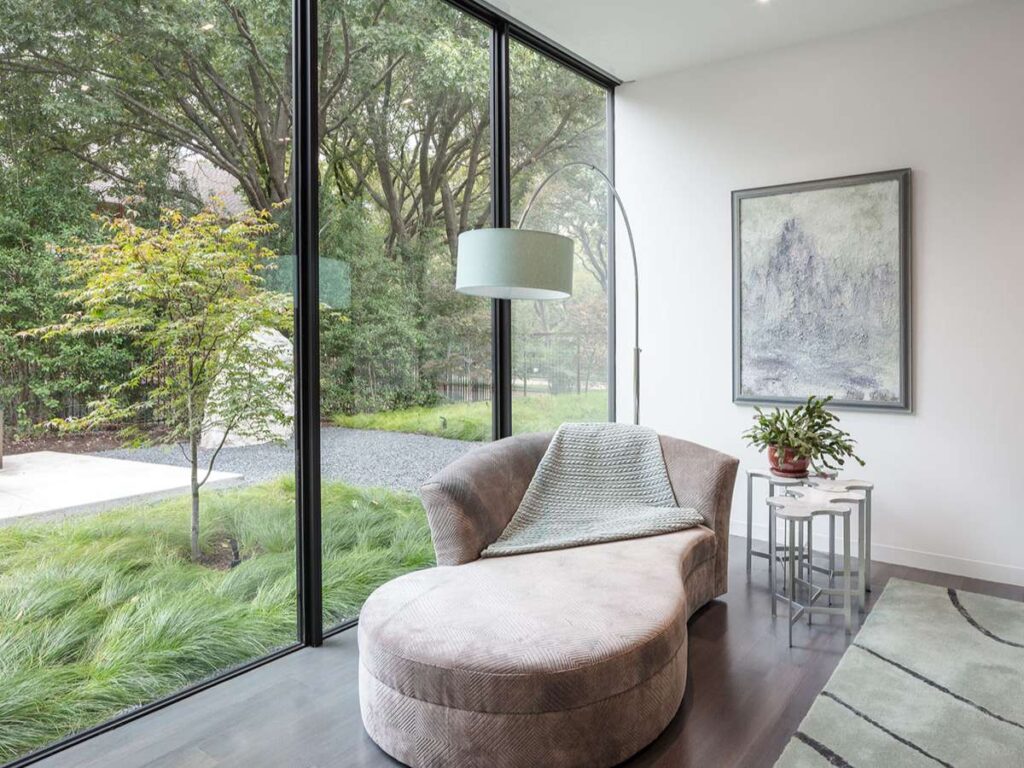
7. Slim Profile Aluminum Windows
While overseeing a modern home build, I noticed how the new windows completely changed the way the rooms felt. The slim aluminum frames made the glass look almost endless, letting in more light and giving the interiors a modern, open feel.
These are windows with narrow aluminum frames that maximize glass area, and this is a perfect example of how a small design change can make a big difference in both style and function.
Key Features and Materials
- Narrow Frame Design: Reduces visible framing to expand the glass surface. Creates clean sightlines and a modern architectural look.
- Aluminum Construction: Lightweight yet strong, allowing for thinner frames without losing stability. Resists warping, swelling, or cracking over time.
- Finish Options: Powder coating or anodizing protects against corrosion. Available in multiple colors to complement building exteriors.
- Thermal Break Technology: Incorporates an insulating barrier in the frame to reduce heat transfer. Improves energy efficiency in various climates.
Best Applications
- Modern Homes: Enhances open-plan designs with uninterrupted outdoor views. Fits seamlessly into contemporary architecture.
- Boutique Hotels: Adds a sleek look to guest rooms while increasing daylight. Works well in both coastal and urban locations.
- Commercial Offices: Creates bright, inspiring interiors while maintaining structural strength.
Performance and Maintenance
Aluminum frames require minimal upkeep compared to wood. Periodic cleaning with mild soap and water keeps them looking new. In coastal regions, a high-quality finish helps protect against salt corrosion. Regular checks of seals and glazing maintain thermal performance.
Why Choose This Design
Slim profile aluminum windows bring in more light and keep views clear while offering long-lasting durability. However, aluminum can conduct heat more easily than some other materials, so choosing models with proper thermal breaks is important for maintaining comfort indoors.
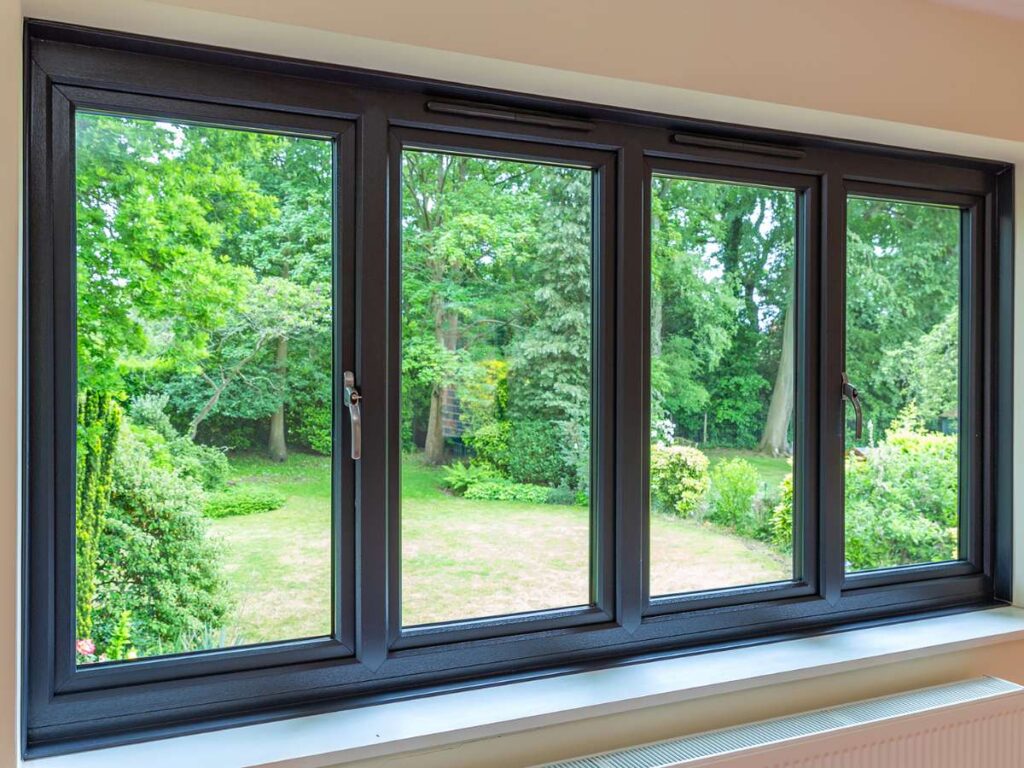
8. Smart Windows with Motorized Blinds and Sensors
During a tour of a newly built office tower, I noticed the windows adjusting themselves as clouds passed by. The blinds lowered slightly when the sunlight became intense, then lifted again to let in more daylight as the sky cleared. These are smart windows with motorized blinds and sensors, and this is a clear example of how technology can create comfort, save energy, and make managing a building easier.
Key Features and Materials
- Integrated Motorized Blinds: Built into the glass unit, so they stay clean and protected from dust. Operated by remote control, wall switch, or an app.
- Light and Temperature Sensors: Adjust blinds automatically based on sunlight levels or indoor temperature. Helps keep rooms bright without overheating.
- Customizable Glass Options: Can be clear, tinted, or Low-E coated. Each type affects light control, energy efficiency, and glare reduction.
- Quiet Motor Operation: Uses low-noise motors, so adjustments are barely noticeable. Adds to the sense of a seamless experience.
Best Applications
- Hotels and Resorts: Lets guests control light and privacy without touching blinds. Offers convenience while maintaining a neat appearance.
- Greenhouses: Manages light exposure for plants throughout the day. Reduces the need for manual adjustments.
- Conference Rooms: Quickly changes lighting for presentations or video calls. Improves comfort and focus for attendees.
Performance and Maintenance
Since the blinds are sealed inside the glass, they require almost no cleaning. Motors should be checked periodically to ensure smooth operation. Sensor calibration may be needed occasionally to maintain accurate adjustments.
Why Choose This Design
Smart windows with motorized blinds and sensors provide a blend of comfort, style, and efficiency. However, they may involve higher upfront costs and more specialized installation, so it is worth planning the budget carefully to match long-term benefits.
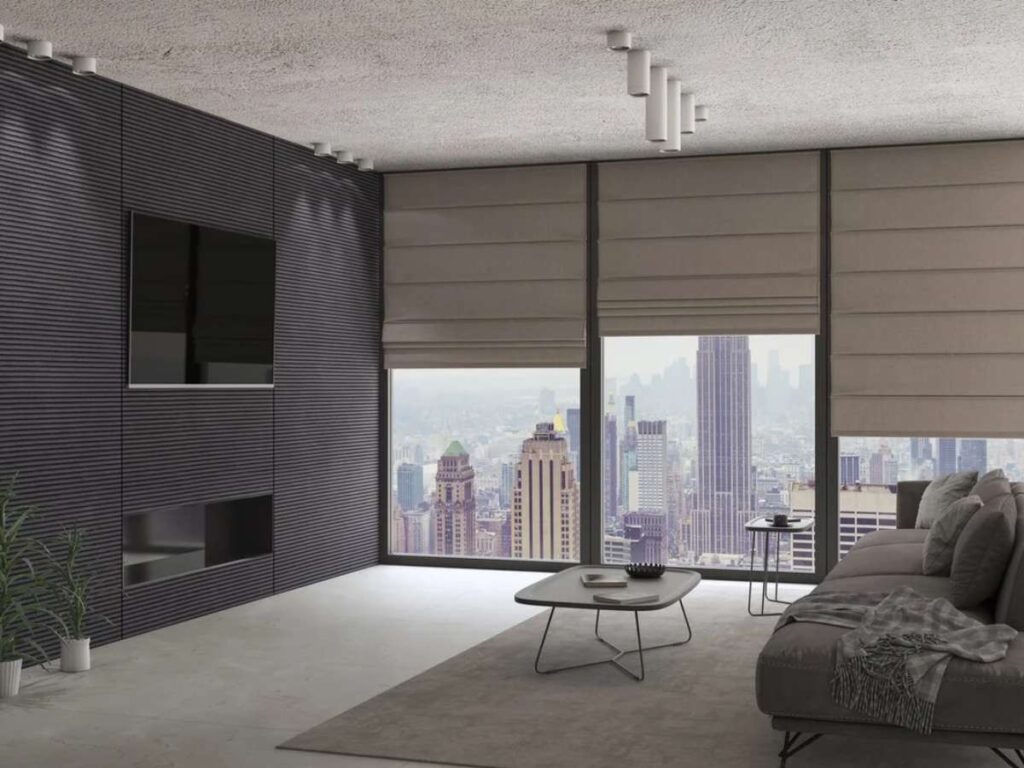
9. High-Performance Insulated Windows with Low-E Glazing
While walking through a recently completed hotel project, I noticed how comfortable the rooms felt with large windows facing sun. The secret was high-performance insulated windows with Low-E glazing, which blocked unwanted heat while still letting in light. These are insulated glass units with a special coating called Low-E, and this is a clear example of how advanced glass technology can improve comfort and long-term value.
Key Features and Materials
- Low-E Coating: A microscopically thin layer that reflects infrared heat while allowing visible light to pass through. Helps keep interiors cooler in summer and warmer in winter.
- Insulated Glass Units: Two or three panes of glass separated by air or gas-filled spaces. Improves thermal performance and reduces energy loss.
- Gas Fills: Argon or krypton gas between panes adds insulation. Slows down heat transfer better than regular air.
- Frame Compatibility: Works with aluminum, vinyl, or wood frames. Performance can be further improved when paired with thermally broken frames.
Best Applications
- Hotels and Resorts: Maintains guest comfort while lowering heating and cooling costs. Suitable for properties in both hot and cold climates.
- Modern Homes: Improves indoor comfort without sacrificing window size or style. Works well in open-plan designs with large glass areas.
- Office Buildings: Reduces glare and temperature swings, creating a better work environment.
Performance and Maintenance
Cleaning is the same as with standard glass, though gentle products help preserve the coating. Seals should be checked periodically to avoid moisture buildup between panes. With proper care, these windows can perform effectively for decades.
Why Choose This Design
High-performance insulated windows with Low-E glazing deliver comfort, energy savings, and year-round performance. However, they can be heavier than standard windows, which means installation may require extra planning and stronger framing support.
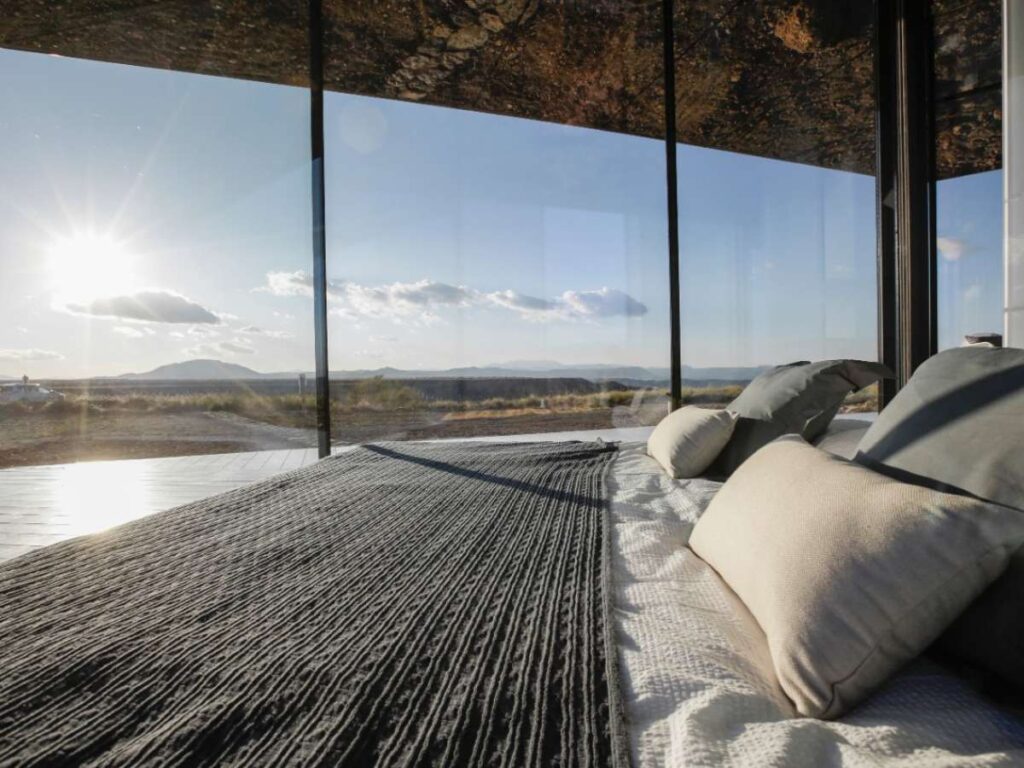
10. Windows with Integrated Ventilation Systems
During a visit to a renovated office space, I noticed how fresh the air felt even with the windows closed. The design used windows with integrated ventilation systems, allowing controlled airflow without compromising security or comfort. These are windows built with discreet vents or mechanical inserts that bring in fresh air, and this shows how design can improve indoor quality while maintaining efficiency.
Key Features and Materials
- Built-In Vents: Hidden openings within the frame allow fresh air to flow indoors. Designed to prevent drafts and maintain a comfortable temperature.
- Adjustable Airflow: Allows users to control how much air enters. Some models have manual sliders, while others are automated.
- Weather Protection: Special covers or mesh screens block rain, dust, and insects from entering. Helps keep indoor air cleaner.
- Frame Compatibility: Works with aluminum, uPVC, or wood frames. Available in various styles to match building aesthetics.
Best Applications
- Hotels and Inns: Offers guests fresh air without requiring them to open windows fully. Improves comfort and privacy.
- Greenhouses: Helps regulate air exchange for plants while keeping pests out.
- Office Buildings: Maintains a steady supply of fresh air, which can boost productivity and reduce reliance on HVAC systems.
Performance and Maintenance
Cleaning the vents periodically keeps airflow smooth. Filters, if installed, should be replaced or cleaned as needed to maintain air quality. Checking the seals ensures the window remains energy-efficient when ventilation is closed.
Why Choose This Design
Windows with integrated ventilation systems help improve indoor comfort and air quality without sacrificing safety or style. However, they can allow more outside noise to enter than standard sealed windows, which is why choosing a trusted supplier can help you get models designed for both performance and noise control.
How to Choose the Right Commercial Door and Window Design
Selecting the right commercial door and window design is easier when you focus on what your property truly needs. I have seen owners rush into choices that looked good at first but caused issues later. Taking time to compare styles, materials, and features helps you invest in designs that work well for years.
- Purpose and Function: Think about what each door or window needs to achieve. A lobby entrance may focus on welcoming guests, while a greenhouse may need better airflow and sunlight. Matching the function to the design prevents future problems.
- Material Selection: Aluminum is strong and low maintenance, steel offers extra durability for heavy use, and wood brings warmth but may need more care. Each material has strengths and limits, so choose based on your priorities and property style.
- Glass and Glazing Options: Low-E coatings can improve energy efficiency, double glazing boosts insulation, and laminated glass adds safety. The right glass choice depends on whether you value comfort, savings, or security most.
- Climate and Location: Properties in coastal areas benefit from corrosion-resistant finishes. In colder climates, thermal breaks and insulated glazing keep interiors comfortable. Local weather patterns should guide your design decisions.
- Maintenance and Longevity: Even the best-looking design loses appeal if it requires frequent repairs or hard-to-find parts. A reliable supplier with a history of quality support can help extend the lifespan of your investment.
By weighing these factors carefully, you can choose commercial door and window designs that balance appearance, performance, and long-term value for your property. Vallisco, a trusted door and window manufacturer, offers options that align with these priorities.
Conclusion
We’ve explored the latest trends shaping commercial doors and windows, from sleek frames to smart systems. Each choice you make changes to how people experience your building.
I remember walking into a space that felt instantly inviting just because the entryway design was so well thought out. You can create that same effect. The right design is out there waiting for you.
Which trend speaks to you most?
Let’s talk about your project and bring it to life. Contact Vallisco today!
Learn More: Recommended Reads
Want to see more products? We’ve got plenty of options that might just be the perfect fit for you:
Still haven’t found what you’re looking for? Don’t hesitate to contact us. We’re available around the clock to assist you.


